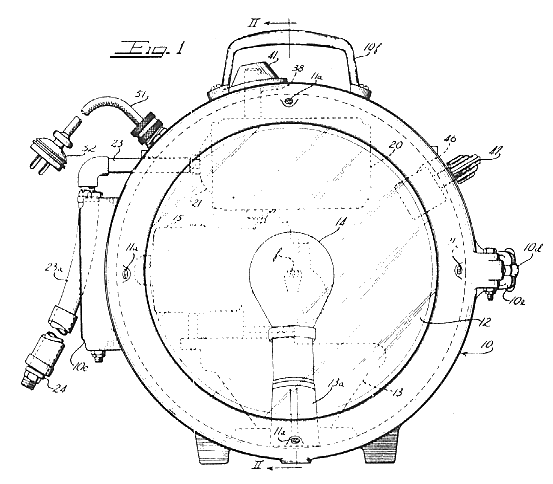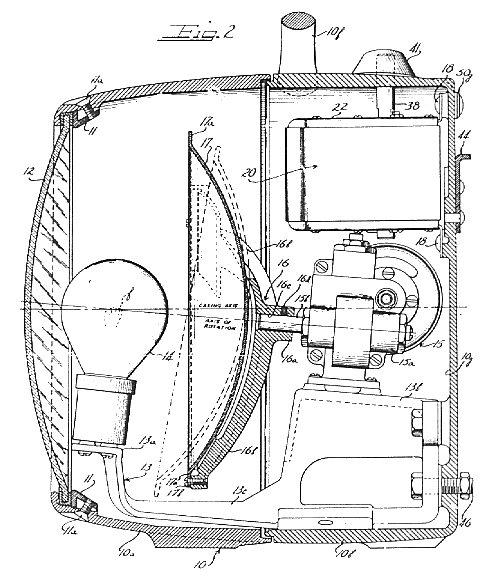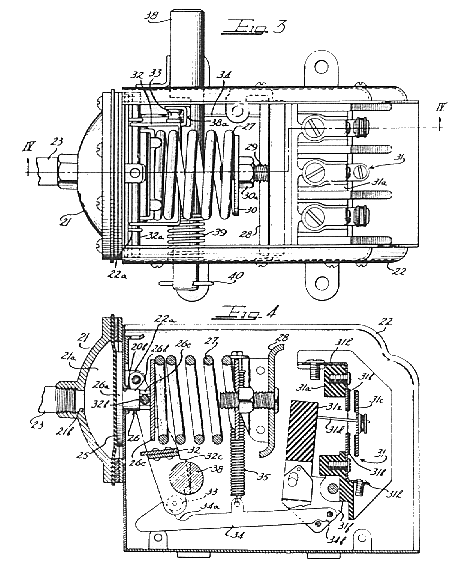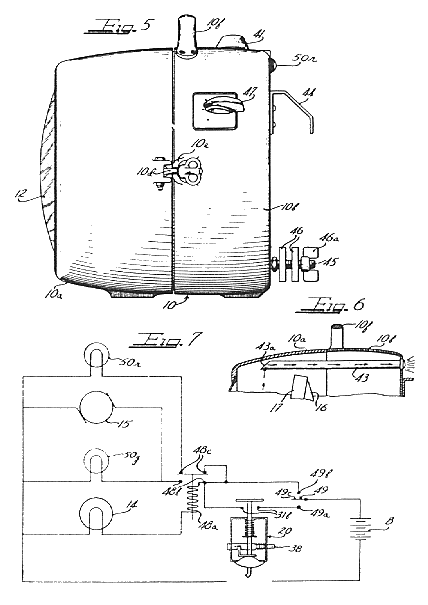



A warning light of this type is readily portable and capable of being quickly mounted upon
any car or engine of the train.
It is adaptable for use on railroad trains, street cars, busses, or similar vehicles.
This warning light provides for a positive and reliable indication that the train, on which it is
mounted, is slowing down or stopped.
Figure 1 is a front elevational view of the assembled warning light unit.
Figure 2 is a sectional view taken on the plane II-II of Figure 1.
Figure 3 is an enlarged scale sectional view of the pressure responsive switch
incorporated in the assemblage of Figure 1 and 2, showing in particular, the
manually resettable latch.
Figure 4 is a sectional view taken on the plane IV-IV of Figure 3.
Figure 5 is a reduced scale side elevational view of the warning light of Figure
1.
Figure 6 is a reduced scale, partial, sectional view, similar to Figure 2,
illustrating a warning light embodying a tell-tale indicator.
Figure 7 is a schematic view of a control circuit for a railroad warning light
embodying this invention.
A hollow closed casing 10, of generally cylindrical configuration, may be defined by two cup-shaped half parts 10a and 10b which are pivoted together by cooperating hinges 10 and locked together in a closed position by a tunble bolt clamp 10d mounted on one of the casing halves and cooperating with bifurcated keeper 10e on the other casing half. A handle 10f is suitably secured to one end of the casing halves 10b to permit the light unit to be conveniently transported.
It should be noted that through utilization of a common support bracket 13 for both light bulb 14 and motor 15, the alignment of the axis of motor output shaft 15b with respect to the filament f is fixed and that the unit may be repeatedly disassembled and assembled for maintenance or repair without incurring any alignment problems.
A reflector supporting spider 16 is rotated by output shaft 15b of the motor unit 15. Such spider comprises an integral casting having a hub portion 16a and a plurality of angularly spaced radially extending arm portions 16b. Hub portion 16a is provided with a bore 16c to permit the mounting of the spider on the output shaft 15b and such bore 16c is angularly eccentrically disposed relative to the peripheries of the arm portions 16b. Hence, when output shaft 15b is rotated by motor 15, the peripheries of the arm portions 16b of the spider 16 will move in a conically eccentric path with respect to the central axis of the casing 10.
A light reflecting disk 17 is provided which is generally of a circular peripheral configuration and which is preferably parabolically formed, although outher types of curved surfaces may be employed, depending on the specific beam characteristics desired to be produced by the reflector. The circular rim portion of 17a of the reflector 17 is secured to the peripheries of the spider arms 16b by suitable screws 17b. It is apparent that the the reflecting axis of the reflector 17 will be angularly disposed relative to its axis of rotation provided by the output shaft 15b. As a result, the reflector will cyclically shift in position relative to the light source f and a wobbled beam will be projected outwardly through lens 12, such beam being wobbled over a generally conical path. To facilitate the initial adjustment of the location of the filament f of the light bulb 15 with respect to the focal point of the reflector 17, the reflector supporting spider 16 is axially adjustable on the motor output shaft 15b and may be secured in any desired position by set screw 16d. In this manner, accurate focusing of the reflected beam may be conveniently produced.
If a red colored signal is desired, a red colored bulb may be employed, or preferably, by appropriate tinting of lens 12.
In accordance with this invention, a manually resettable latch plunger 38 is
provided which cooperates in a unique manner with the pressure switch 20 illustrated in
Figure 3. Latch plunger 38 may conveniently comprise a solid or tubular rod
which is slidably journaled in aligned aperatures provided in two opposed sidewalls of pressure
switch housing 22. Plunger 38 is located relative to one of the moving parts of
the electrical switch operating linkage so as to intersect the path of movement of such moving
part, for example, primary link 32. According to one operating procedure, the function
of plunger 38 is to freely permit clockwise movements of the primary link 32
through a range corresponding to the normal pressure variations upon the diaphram 25
which are produced by normal braking and stopping of the train. Upon an emergency application
of hte brakes, wherein the pressure on the diaphram 25 is reduced to a much greater
extent, or upon failure of the brake pressure system, the primary link 32 will move
clockwise a greater distance, such movement resulting from the constant bias maintained by
spring 27. The contacts (moveable contacts 31c and fixed contacts
31b) will be closed to energize the warning light. Upon the occurrence of such
emergency conditions, it is the function of the latch plunger 38 to retain the primary link
32 in such extreme position irrespective of the restoration of the full brake system
pressure upon the diaphram 25. It is then necessary that the latch plunger 38
be manually reset to its normal position to de-energize the warning light.
According to an alternate procedure, the plunger 38 may be employed to lock the
pressure switch unit 20 in its closed contact position upon any reduction in brake system
pressure sufficient to produce a substantial slowing or stoppage of the train. Then every time the
train slows down or stops it will be protected by the warning light.
To accomplish these functions, a notch 38a in plunger 38 cut to a depth
of predetermined diaphram 25 movement based on system brake pressure. This notch
38a engages lip 32c of the primary link 32. Exceeding the
predetermined pressure reduction will cause dis-engagement of notch 38a with lip
32c, causing an axial shift of plunger 38 by way of spring 39.
In daytime operations, it often happens that the warning signal will be clearly visible to a person standing in front of the lens 12 but a person standing behind the casing 10 will not be able to readily ascertain whether the signal is properly operating. This is a source of annoyance to the brakeman at the rear end of the train who must either move to a position behind the train or lean over the warning light in a precarious position to ascertain the whether the warning light is properly functioning.
To provide a positive indication on the rear side of the warning light, itelf, as to the operating
condition of the light, a pair of red and green indicating lights 50r and 50g are
mounted on the rear wall of casing 10 and are selectively energized by a control circuit,
so as to indicate the operating condition of the bulb 14. A modified form of and
indicator for this invention is illustrated in Figure 6, employing a light transmitting rod
43 to provide the tell-tale indication. Such rod 43 is mounted in casing
10 in any convenient manner so that the rear end of the casing 10 and the
front end is disposed in overlying relationship to light bulb 14. This front end of rod
43 is provided with an angularly disposed planar surface 43a. The rod
43 is formed of a suitable plastic or quartz exhibiting "edge lighting" characteristics.
With such materials, light rays impinging upon the inner end of rod 43 will be
reflected by teh angularity disposed planar surface 43a and transmitted along the length
of the rod 43 rearwardly out of the casing 10 in the manner indicated by the
arrows in Figure 7 .
As best shown in Figure 5, suitable mounting arrangements are provided on the rear face of the warning light casing 10 so as to permit the warning light to be permanently or temporarily mounted in a desired position upon an engine or car of a train. Such mounting arrangement may comprise a generally "U-shaped" bracket 44 rigidly secured to the back wall 10g of the casing half 10b near the top thereof and a rearwardly projecting bolt 45 disposed near the bottom of the casing 10 carrying a pair of clamping washers 46 and a thumb screw type clamp 46a threaded thereon.
The preferred control circuit for this warning light embodies a relay and a manual operable switch. Such switch and relay unit may be also conveniently mounted in and upon the casing 10 and has been shown schematically in Figure 6. The operating knob 47 for the switch of this assembly is disposed on the exterior of the casing 10.
In Figure 7, the relay forming part of the combined relay and switch unit shown in
schematically at 48, and is of the well known type having an energizing coil
48a and two sets of contacts 48b and 48c, which are respectively
normally open and normally closed. The switch unit (switch to which knob 47 is
attached in Figure 6) is indicated as 49 and is of the single pole double throw
variety.
When the blade 49c of switch 49 is in engagement with contact
49a, the unit is set up for automatic operation. Upon closure of the contacts
(31b and 31c of pressure switch 20, the relay coil 48a is
energized, and concurrently, the warning light bulb, 14. The warning light bulb
14 is connected in series with teh relay coil 48a. Energization of the relay coil
48a causes closure of contacts 48b which in turn, energizes the motor
15 and green indicating light 50g. Concurrently, the red indicating light
50r is de-energized.
Any failure in the power supply circuit to the warning light bulb 14, or the burning
out of bulb 14, immediately de-energizes the relay coil 48a and returns the
circuit to that shown in Figure 7, wherein the red indicating light immediately reveals a
defect in the circuit.
Electrical connections to the unit are made with a cord 51 with a plug 52.
| 10350 Gyralite: | photos | spec. sheets |
|---|